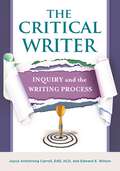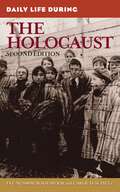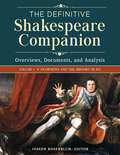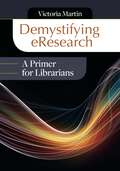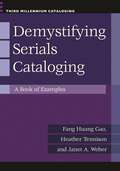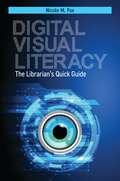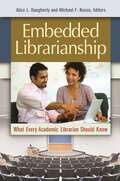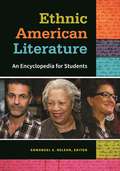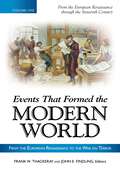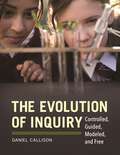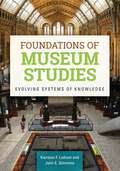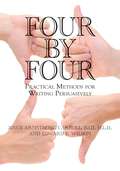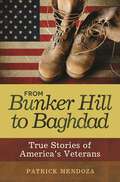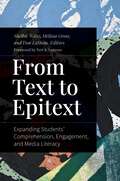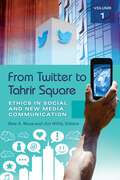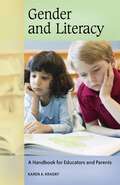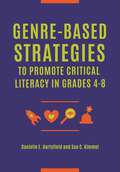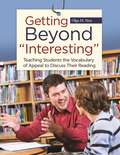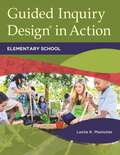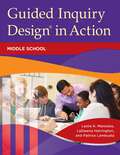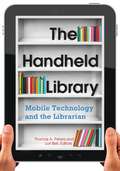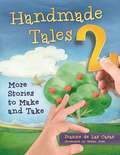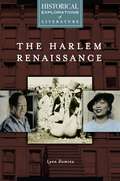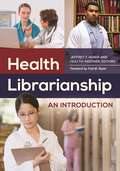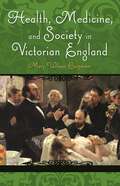- Table View
- List View
The Critical Writer: Inquiry and the Writing Process
by Joyce Armstrong Carroll Edward E. WilsonHigh-quality original writing doesn't happen by accident; it results from a logical, inquiry-based process. Educators will be able to apply the concepts and techniques in this book to help their students master the critical writing process.Many students tremble at the mere thought of "the dreaded research paper" when in fact the inquiry process that should be applied for a writing project should be an engaging and exciting mental activity. This work explains how teachers and librarians can guide the critical writing process to go hand-in-hand with inquiry and produce logical and carefully honed papers.The Critical Writer: Inquiry and the Writing Process starts with a general treatment of inquiry to detailed coverage of specific teaching strategies, explaining how critical writers should make the proper emendations during prewriting and while drafting as well as during the revising process. The book presents fresh information and teaching techniques that can be applied by anyone in the field of education with students of any grade level; examples from kindergarten through instructors in teacher training are included.
Daily Life During the Holocaust (The Greenwood Press Daily Life Through History Series)
by Eve Nussbaum Soumerai Carol D. SchulzThe Holocaust—one of the most horrific examples of man's inhumanity to man in recorded history—resulted in the genocide of millions of people, most of them Jews. This volume explores the daily lives of the Holocaust victims and their heroic efforts to maintain a normal existence under inhumane conditions. Readers will learn about the effects of pogroms, Jewish ghettoes, Nazi rule, and deportation on everyday tasks like going to school, practicing religion, or eating dinner. Chapters on life in the concentration camps describe the incomprehensible conditions that plagued the inmates and the ways in which they managed to survive. Soumerai, a survivor herself, offers a unique perspective on the events. Coverage also includes accounts of resistance and the role of rescuers. Four new chapters explore current human rights abuses, including Holocaust denials, modern genocide, and human trafficking, enabling readers to contrast present and past events. In addition to a timeline, a glossary, and engaging illustrations, the second edition also features an extensive bibliography and resource center that guides student researchers toward web sites, organizations, films, and books on the Holocaust and other human rights abuses.Primary source testimonies from survivors provide powerful insight into the devastating effects of Nazi rule on people's lives. Soumerai, a survivor herself, offers a unique perspective on the events and insight into the persecution of non-Jews: Gypsies, gays, clergy who protested or protected victims, Communists, Jehovah's Witnesses, the mentally ill and handicapped. Readers will explore the effects of pogroms, Jewish ghettoes, Nazi rule, and deportation on everyday tasks like going to school, practicing religion, or eating dinner. Chapters on life in the concentration camps describe the incomprehensible conditions within the camps, including the ways in which inmates managed to survive: avoiding the infirmary, rationing food, utilizing the market system to trade for goods and clothing. Four new chapters shed a modern light on the events of the Holocaust, exploring human rights abuses that continue even today, including Holocaust Denials; genocide in Cambodia, Rwanda, and Sudan; and child slavery and human trafficking. The new material allows readers to compare and contrast present and past human rights abuses, exploring what lessons we have learned, if any, from the Holocaust. An expanded bibliography and resource center guides readers toward related web sites, organizations, films and books related to the Holocaust, modern-day slavery and genocide, child soldiers, and related human rights topics. Illustrations, a timeline of events and a glossary of terms are also included, making this a comprehensive resource for student researchers.
The Definitive Shakespeare Companion [4 volumes]: Overviews, Documents, and Analysis [4 volumes]
by Editor Joseph RosenblumThis expansive four-volume work gives students detailed explanations of Shakespeare's plays and poems and also covers his age, life, theater, texts, and language. Numerous excerpts from primary source historical documents contextualize his works, while reviews of productions chronicle his performance history and reception.Shakespeare's works often served to convey simple truths, but they are also complex, multilayered masterpieces. Shakespeare drew on varied sources to create his plays, and while the plays are sometimes set in worlds before the Elizabethan age, they nonetheless parallel and comment on situations in his own era. Written with the needs of students in mind, this four-volume set demystifies Shakespeare for today's readers and provides the necessary perspective and analysis students need to better appreciate the genius of his work. This indispensable ready reference examines Shakespeare's plots, language, and themes; his use of sources and exploration of issues important to his age; the interpretation of his works through productions from the Renaissance to the present; and the critical reaction to key questions concerning his writings. The book provides coverage of each key play and poems in discrete sections, with each section presenting summaries; discussions of themes, characters, language, and imagery; and clear explications of key passages. Readers will be able to inspect historical documents related to the topics explored in the work being discussed and view excerpts from Shakespeare's sources as well as reviews of major productions. The work also provides a comprehensive list of print and electronic resources suitable for student research.
Demystifying eResearch: A Primer for Librarians
by Victoria MartineResearch presents new challenges in managing data. This book explains to librarians and other information specialists what eResearch is, how it impacts library services and collections, and how to contribute to eResearch activities at their parent institutions.Today's librarians need to be technology-savvy information experts who understand how to manage datasets. Demystifying eResearch: A Primer for Librarians prepares librarians for careers that involve eResearch, clearly defining what it is and how it impacts library services and collections, explaining key terms and concepts, and explaining the importance of the field. You will come to understand exactly how the use of networked computing technologies enhances and supports collaboration and innovative methods particularly in scientific research, learn about eResearch library initiatives and best practices, and recognize the professional development opportunities that eResearch offers.This book takes the broad approach to the complex topic of eResearch and how it pertains to the library community, providing an introduction that will be accessible to readers without a background in electronic research. The author presents a conceptual overview of eResearch with real-world examples of electronic research activities to quickly increase your familiarity with eResearch and awareness of the current state of eResearch librarianship.
Demystifying Serials Cataloging: A Book of Examples (Third Millennium Cataloging)
by Fang Huang Gao Heather Tennison Janet A. WeberThis essential reference teaches library staff how to handle the most common and confusing problems in serials cataloging by providing clear examples, practice exercises, and helpful advice based on experience.Serials cataloging can be an overwhelming task that frustrates even the most seasoned professional. This book provides simple guidance and real-world examples to illustrate best practices in serials cataloging.Demystifying Serials Cataloging: A Book of Examples is a reliable reference for learning how to catalog serials or improve cataloging skills. The book covers important elements of descriptive cataloging of serial publications such as explanations, sample records, applicable cataloging rules, and images of the serials. Examples demonstrate best practices and guidelines from the industry's leading cataloging standards including Anglo-American Cataloguing Rules: Second Revised Edition; CONSER Cataloging Manual; Library of Congress Rule Interpretation; and OCLC Bibliographic Formats and Standards. Each chapter contains helpful practice exercises to ensure understanding and reinforce learning.
Digital Visual Literacy: The Librarian's Quick Guide
by Nicole M. FoxDesigned to introduce visual literacy to instructional librarians, this book shows librarians how to make visual literacy relevant and engaging by framing it as a digital skill.Millions of images are uploaded to social media every day, and students are increasingly being asked to participate in such image-rich research projects as websites and blogs. Image manipulation and photo editing are commonplace, but the visual literacy skills needed to detect that kind of misinformation aren't.Students need help learning how to find, evaluate, and use images in an ethical and effective manner. Digital Visual Literacy is designed to introduce visual literacy to instructional librarians. This concise introduction teaches visual literacy as a digital skill, complete with digital humanities-based workshops and assignments to make instruction informative and engaging. It covers all aspects of visual literacy, from copyright to image evaluation. Each chapter clearly explains visual literacy standards and proficiencies and offers practical instructional assignments, in-class demonstrations, and more through the use of digital humanities tools.
Embedded Librarianship: What Every Academic Librarian Should Know
by Alice L. Daugherty and Michael F. RussoIn the ongoing evolution of the academic library, embedded librarianship has become an important topic of debate across levels and departments. This book delves into the concept, examining everything from theory to best practices.Is the embedded librarian an equal partner in the course, or is the librarian perceived as a "value-added" extra? What is the place of technology in this effort? Is there a line librarians should not cross? Taking into account both theory and practice to discuss multiple facets of the subject, Embedded Librarianship: What Every Academic Librarian Should Know thoroughly examines these questions and more from the perspectives of experienced embedded librarian contributors who have worked in higher education settings. The chapters illuminate the benefits and challenges of embedding, explain the planning required to set up an embedded course, identify the different forms of embedding, and consider information literacy instruction in various contexts.Readers who will benefit from this work include not only academic librarians but any professor who wants their students to be able to do better research in their fields.
Ethnic American Literature: An Encyclopedia for Students
by Emmanuel S. NelsonUnlike any other book of its kind, this volume celebrates published works from a broad range of American ethnic groups not often featured in the typical canon of literature.This culturally rich encyclopedia contains 160 alphabetically arranged entries on African American, Asian American, Latino/a, and Native American literary traditions, among others. The book introduces the uniquely American mosaic of multicultural literature by chronicling the achievements of American writers of non-European descent and highlighting the ethnic diversity of works from the colonial era to the present. The work features engaging topics like the civil rights movement, bilingualism, assimilation, and border narratives. Entries provide historical overviews of literary periods along with profiles of major authors and great works, including Toni Morrison, Maxine Hong Kingston, Maya Angelou, Sherman Alexie, A Raisin in the Sun, American Born Chinese, and The House on Mango Street. The book also provides concise overviews of genres not often featured in textbooks, like the Chinese American novel, African American young adult literature, Mexican American autobiography, and Cuban American poetry.
Events That Formed the Modern World [5 volumes]: From the European Renaissance through the War on Terror [5 volumes]
by Frank W. Thackeray and John E. FindlingThis comprehensive five-volume set contains readable essays that describe and interpret the most important global events since the European Renaissance, some accompanied by related document excerpts and primary source materials.What were the effects of the Age of Exploration on today's ethnic groups and social structure? How did the development of moveable type pave the way for Facebook and Twitter? Why is the Reformation so critical for understanding today's religious controversies? This set will help readers answer these questions by exploring the most significant historical events of the modern world.This five-volume set covers times from the Renaissance to the present. Each volume focuses on a specific historic period and examines 12 events within those time frames that changed the world. Each entry provides an introduction that lays out factual material in a chronological manner, an in-depth essay interpreting the event's significance, and an annotated bibliography of the most important current works on the topic. Select entries are followed by primary sources pertaining to the event under consideration, such as diary entries. Targeted to both general readers as well as entry-level university students, this book also directly supports high school and undergraduate curricula, allowing students to identify and contextualize events in order to think critically about their causes, aftermath, and legacy.
The Evolution of Inquiry: Controlled, Guided, Modeled, and Free
by Daniel CallisonDefining the progression toward inquiry learning, this book provides an extensive overview of the past five decades and the evolution of inquiry in science, history, language arts, and information literacy studies.Information inquiry is a basic skill for those who examine information as a science, and its principles can be applied across the K-12 curriculum. Built around reflective reviews of more than two dozen articles from School Library (Media Activities) Monthly, this helpful book shows the evolution, adoption, and application of the inquiry learning process to the school library teaching/learning environment. Four levels of inquiry—controlled, guided, open, and free—are explored in association with the emerging national Common Core curriculum and the Standards for the 21st-Century Learner from the American Association of School Librarians. With the growing interest in the concept of inquiry and inquiry learning, you may find yourself needing to distinguish between the existing models and their applications. To help you do that, the book provides you with rich, historical context that clarifies the models, and it also projects future applications of inquiry and learner-centered teaching through school information literacy programs. These new applications, such as graphic inquiry, argumentation for inquiry, and the student as information scientist, offer tangible examples you can use to enrich the expanding information literacy curriculum.
Foundations of Museum Studies: Evolving Systems of Knowledge
by Kiersten F. Latham John E. SimmonsThis broad introduction to museums benefits all educators who teach introductory museum studies, addressing the discipline from a holistic, dynamic, and document-centered perspective.Museums serve to help us understand the past and navigate our future—as individuals, as societies, and as a global community. A careful and accurate assessment of a museum's purpose is crucial to its ability to serve its users effectively. Foundations of Museum Studies: Evolving Systems of Knowledge offers a holistic introduction to museums and the study of them from the perspective of specialization in museum studies within the context of library and information science (LIS).The book strikes a balance between theory and practice, examining museums from a systems perspective that considers museums to be document-centered institutions—that objects are documents that generate and convey information, meaning, and inspiration. The authors utilize examples drawn from their experience with institutions in the United States that can be applied to museums across the world. Future museum professionals who read this book will have a broader perspective, an expanded skill set, and the adaptability to span the spectrum of traditional academic disciplines.
Four by Four: Practical Methods for Writing Persuasively
by Joyce Armstrong Carroll Edward E. Wilson New Jersey Writing ProjectGeared toward English and social studies teachers as well as school librarians, this book provides a clear and concise way to approach the teaching of persuasive writing—and to develop the skills students need to excel on high stakes tests as well.In Four by Four: Practical Methods for Writing Persuasively, well-known authors and teachers of writing Joyce Armstrong Carroll and Edward E. Wilson provide a practical guide to teaching students how to write persuasively. Organized in four chapters, each containing four sections, the text opens with a history of rhetoric that serves as a logical preface to the persuasive writing basics, guides, and patterns presented in the remainder of the book. It covers topics such as the Carroll/Wilson Inquiry Schemata as a data collection technique for persuasive writing, planning and organizing a persuasive paper, strategies for efficient editing, and writing the conclusion. Appropriate for educators who work with fourth-grade through college-level students in English and social studies, this guidebook spotlights the research process, a 21st-century skill that teachers should teach collaboratively with their school librarians.
From Bunker Hill to Baghdad: True Stories of America's Veterans
by Patrick MendozaThese compelling, enlightening, and often highly personal experiences tell stories of average citizens as well as historical figures who made huge sacrifices by serving in the military, giving the reader new perspectives on war, and its real costs.Wars are generally started by those holding power—those whose names are recorded in history books—yet they are fought by the average citizen. In wartime, a single person's action can change the course of history. From Bunker Hill to Baghdad: True Stories of America's Veterans presents stories told by just a handful of the limitless number of men and women who put their lives on the line for the lives of others in every major American military conflict from the Revolutionary War to the present. A fantastic resource for storytellers, this collection can also be used for student research as well as for read-alouds.Many of the informative, entertaining, and uplifting stories in this book are derived from the interviews author and storyteller Pat Mendoza conducted with veterans or family members of veterans during his travels throughout the United States. The book introduces general readers and those interested in the experiences of war veterans to a diverse selection of individuals who fought in America's wars—military service people and others—and to their amazing experiences, some of which have never been previously published. For educators who work with students in grade four to the college level, these poignant, real-life stories of American military history will serve to supplement curricula and help make their students' studies come to life and gain meaning and relevance.
From Text to Epitext: Expanding Students' Comprehension, Engagement, and Media Literacy
by Shelbie Witte, et al.This volume explains how analyzing textual elements that aren't part of the text but connected to it can be used with K–16 students to improve comprehension, engagement, critical thinking, and media literacy.Beginning with an introduction that briefly explains Genette's theory of paratext and discusses the functions of epitext theory, this book comprises theory-to-practice chapters that showcase ways in which teachers and librarians can use elements independent of a text to discuss texts and media with students. Chapters include a practitioner's section specifying practical approaches and explanations for how to use epitext.Scaffolding an application of theory to practice, this title provides educators with an original approach to increasing literacy engagement and integration as well as for increasing media literacy and critical thinking. It includes practical ideas for using epitext in the classroom to promote critical thinking and for collaboration between teachers and librarians. It also includes editorial sidebars that provide additional "how-to" ideas, support deep thinking, make connections to relevant content in other chapters, and provide examples for students in K–16 classrooms.
From Twitter to Tahrir Square [2 volumes]: Ethics in Social and New Media Communication [2 volumes]
by Bala A. Musa and Jim WillisThis timely guide examines the influence of social media in private, public, and professional settings, particularly the ethical implications of the cultural changes and trends created by their use.In the quest for quick dissemination of information, web users and content providers find both opportunity and liability in digital broadcasts. Examples abound: Twitter members tap into news reports well in advance of traditional print media, but stories are prone to inaccuracies and misinformation; Facebook shares useful data mined from member profiles, but this sharing often compromises privacy. It is no surprise that use of social media gives rise to a host of moral dilemmas never before encountered. This book sheds light on the effects of this new medium on the individual and society.Through two volumes chock full of topics found in news headlines everyday, the authors look at evolving trends in social media and their impact on privacy, politics, and journalism. The first volume explores the role of this technology on national and international security. Volume 2 focuses on the individual as both a producer and consumer of internet content, showing how the media itself is changing notions of self-identity, relationships, and popular culture. The book's content covers such topics as individual and community psychology, citizen journalism, and corporate technology.
Gender and Literacy: A Handbook for Educators and Parents (Handbooks for Educators and Parents)
by Karen A. KrasnyThis work offers parents, educators, and librarians a practical guide to discovering the ways gender identities are constructed through literacy practices, providing recommendations for addressing gender inequities in schools and in the community at large.Gender and Literacy: A Handbook for Educators and Parents focuses on issues related to the gendered experience of students from pre-kindergarten through grade 12, promoting an understanding that the issues surrounding gender cannot be reduced to broad generalizations. Author Karen A. Krasny seeks to make clear the complex notion of gender construction within the context of redefining what constitutes legitimate literacy practices in schools.This handbook will help to guide educators, parents, and librarians by assisting them in the selection and evaluation of print and media resources. The first chapter explains the need to understand the complex relationship between gender and literacy. The bulk of the book provides readers with a critical review of the studies conducted to investigate gendered literacy practices, while the last three chapters focus on actionable strategies and policy making.
Genre-Based Strategies to Promote Critical Literacy in Grades 4–8
by Danielle E. Hartsfield Sue C. KimmelDraws on critical and radical change theory to equip both aspiring and practicing library and teacher candidates with practical, research-based ideas for enacting critical literacy practices in middle grade libraries and classrooms.Genre Based Strategies to Promote Critical Literacy in Grades 4-8 provides strategies and lesson plans with additional resources and tools for school librarians and teachers to engage middle grade students in reading children's literature through a critical literacy lens. To be critically literate readers and thinkers, students must learn to question what they read, asking themselves who wrote the text, why the text was written, and how the text positions its readers and others. Teaching students how to read from a critical literacy stance is a timely and relevant practice in a world in which text is available instantly and on nearly any mobile device. In many cases, preparation programs for school librarians and teachers do not teach candidates how to incorporate critical literacy practices in library and classroom settings. This book provides both pre-service and in-service school librarians and teachers with that professional development and guidance for teaching critical literacy in children's literature courses.
Getting Beyond "Interesting": Teaching Students the Vocabulary of Appeal to Discuss Their Reading
by Olga M. NesiMake use of a detailed plan and ready-to-use lessons for teaching appeal terms and Book Hook writing to students.Getting Beyond "Interesting": Teaching Students the Vocabulary of Appeal to Discuss Their Reading is a practical application book that gives librarians all the tools they need to implement the teaching of both appeal terms and Book Hook writing and sharing. When students know how to write Book Hooks and have access to an easy-to-use system for allowing students to share Book Hooks, the result is greatly increased reading through the power of peer recommendations.This book not only supplies a detailed plan for teaching appeal terms and Book Hook writing, but it also provides two extensive appendices containing all the black line masters and forms needed to implement these lessons. As a result, practitioners will be able to enhance their students' reading culture through increased sharing of reading—and most importantly, by empowering students with the ability to clearly define their reading preferences.
Guided Inquiry Design® in Action: Elementary School (Libraries Unlimited Guided Inquiry)
by Leslie K. ManiotesThis book explores Guided Inquiry Design®, a simple, practical model that addresses all areas of inquiry-based learning and sets the foundation for elementary-age students to learn more deeply.One of three needed for district-wide implementation of GID at all levels, K-12, this book provides an introduction to an educational method that embeds information literacy into content areas and encourages students to acquire a more intimate knowledge of subjects through asking questions and conducting more thorough research. Intended to be used alongside Guided Inquiry Design®, lessons are laid out using the GID session plan templates from Guided Inquiry Design®. Readers can implement these lessons as they are or use them as models in designing their own, similar units customized for their own local or school population and to meet relevant standards and content. Included in these lesson plans are lessons created by educators for increased student interaction that enhance the elementary educator's ability to instruct younger students using the GID process.
Guided Inquiry Design® in Action: Middle School (Libraries Unlimited Guided Inquiry)
by Leslie K. Maniotes LaDawna Harrington Patrice LambustaSupplying classroom-tested lessons and unit plans that can serve as templates, this book demonstrates exactly how to integrate and implement Guided Inquiry Design® (GID) theory into practice.Guided Inquiry is an approach that many educators—thought leaders and practitioners alike—are finding to be well-suited to information-age learning and a way to meet Common Core Standards. For many teachers, librarians, middle school leaders, and curriculum specialists, the biggest challenge is finding examples of guided inquiry in practice applicable to their own context. This guide offers an easy solution, offering ready-to-use templates and models for implementing Guided Inquiry Design® (GID) in the middle school learning environment. With each supplied lesson laid out according to the session plan templates from GID and a thorough description of the ideal inquiry process from beginning to end, integration and implementation of GID is attainable.Besides showing how to put GID to best use to achieve five kinds of learning through inquiry, the book provides an explicit structure for developing instructional partnerships and collaborative teams within the school and with the larger community. It enables teachers, school librarians, and other educational partners to consider and plan for achieving outcomes that bring about deep understanding while also addressing curricular goals. Readers will be better equipped to provide an authentic learning environment using collaboration, discussion, and reflection embedded in the sessions, thereby helping their students to be able to think creatively to solve problems.
The Handheld Library: Mobile Technology and the Librarian
by Thomas A. Peters and Lori BellCovering topics such as mobile reference, eBooks, mobile websites, and QR codes, this book examines the effects of the global mobile revolution on libraries and library users—critical information all librarians need.The Handheld Library: Mobile Technology and the Librarian provides the information and guidance librarians need to adapt themselves and their facilities to the mobile revolution—the fastest, most diffuse worldwide technological innovation in human history.The book provides an up-to-date survey of how mobile technologies are affecting library use, library services, library systems, librarians, and library users at various types of libraries. The authors cover core topics related to mobile libraries, including mobile reference, eBooks, mobile websites, and QR codes, and address aspects of the mobile revolution less frequently covered in the literature, such as mobile health information services, the use of mobile technologies on archival work, the impact of the mobile revolution on physical libraries, and the ways in which new mobile technologies are creating professional development opportunities within the profession. While this resource is specifically targeted toward librarians who plan and provide services using mobile technologies, academic, public, and other librarians will also find the ideas and information within useful.
Handmade Tales 2: More Stories to Make and Take
by Dianne de CasasChildren love seeing ordinary objects such as paper and string transformed into extraordinary things. This book provides a collection of fun make-and-take tales that enable educators and librarians to take storytelling to a higher level.Can something as simple as a handkerchief, rubber band, paper plate, or piece of rope be used to captivate children during a storytelling? An expansion of the original, best-selling Handmade Tales book, author and storyteller Dianne de Las Casas provides 25 more clever handmade tales appropriate for pre-kindergarten to third grade. By following her clear instructions on incorporating inexpensive props comprised of everyday items into these fun make-and-take stories, educators and librarians can exponentially expand the appeal of their storytime efforts.Including different types of make-and-take stories like string stories, draw and tell, paper tales, and stories that use other simple props, the handmade tales in this book are ideal for preschool and elementary school teachers and librarians of all experience levels. Storytellers, scout leaders, camp counselors, and others who work with groups of young children will also find these make-and-take stories and instructions invaluable.
The Harlem Renaissance: A Historical Exploration of Literature (Historical Explorations of Literature)
by Lynn DominaA perfect guide for use in high school classes, this book explores the fascinating literature of the Harlem Renaissance, reviewing classic works in the context of the history, society, and culture of its time.The Harlem Renaissance is one of the most interesting eras in African American literature as well as a highly regarded period in our country's literary history. The works produced during this span reflect a turbulent social climate in America … a time fraught with both opportunities and injustices for minorities. In this enlightening guide, author and educator Lynn Domina examines the literature of the Harlem Renaissance along with the cultural and societal factors influencing its writers.This compelling book illuminates the cultural conditions affecting the lives of African Americans everywhere, addressing topics such as prohibition, race riots, racism, interracial marriage, sharecropping, and lynching. Each chapter includes historical background on both the literary work and the author and explores several themes through historical document excerpts and thoughtful analysis to illustrate how literature responded to the surrounding social circumstances. Chapters conclude with a discussion of why and how the literary work remains relevant today.
Health Librarianship: An Introduction
by Jeffrey T. Huber Feili Tu-Keefner James E. Andrews Keith Cogdill Prudence W. Dalrymple Melissa De Santis Michael A. Flannery Sandra G. Franklin Julie K. Gaines Anna Getselman Mary L. Gillaspy Gerald Perry Connie Schardt Katherine Schilling Robert Shapiro Denise Shereff Meredith Solomon Michele A. Spatz Susan Swogger Fay J. Towell Douglas L. VarnerIntended for students interested in careers as health sciences librarians, this insightful book presents a current view of trends and issues in the field of health librarianship from leading scholars and practitioners.With health care reform and the Affordable Care Act driving up demand for ready access to health and biomedical information by both health care providers and healthcare consumers, health librarianship plays a critical role in facilitating access to that information. Health Librarianship: An Introduction places health librarianship within the health care context, covering librarianship within this specific environment as well as other perspectives relevant to health librarianship. The book addresses the basic functions of librarianship—for example, management and administration, public services, and technical services—within the health care context as well as issues unique to health librarianship like health literacy, consumer health, and biomedical informatics. This book is an outstanding textbook for library and information sciences classes and will also be of interest to those considering a career change to health librarianship.
Health, Medicine, and Society in Victorian England (Victorian Life and Times)
by Mary Wilson CarpenterThis work offers a social and cultural history of Victorian medicine "from below," as experienced by ordinary practitioners and patients, often described in their own words.Health, Medicine, and Society in Victorian England is a human story of medicine in 19th-century England. It's a story of how a diverse and competitive assortment of apothecary apprentices, surgeons who learned their trade by doing, and physicians schooled in ancient Greek medicine but lacking in any actual experience with patients, was gradually formed into a medical profession with uniform standards of education and qualification. It's a story of how medical men struggled with "new" diseases such as cholera and "old" ones known for centuries, such as tuberculosis, syphilis, and smallpox, largely in the absence of effective drugs or treatments, and so were often reduced to standing helplessly by as their patients died. It's a story of how surgeons, empowered first by anesthesia and later by antiseptic technique, vastly expanded the field of surgery—sometimes with major benefits for patients, but sometimes with disastrous results. Above all, it's a story of how gender and class ideology dominated both practitioners and patients. Women were stridently excluded from medical education and practice of any kind until the end of the century, but were hailed into the new field of nursing, which was felt to be "natural" to the gentler sex. Only the poor were admitted to hospitals until the last decades of the century, and while they often received compassionate care, they were also treated as "cases" of disease and experimented upon with freedom. Yet because medical knowledge was growing by leaps and bounds, Victorians were fascinated with this new field and wrote novels, poetry, essays, letters, and diaries, which illuminate their experience of health and disease for us. Newly developed techniques of photography, as well as improved print illustrations, help us to picture this fascinating world. This vivid history of Victorian medicine is enriched with many literary examples and visual images drawn from the period.
